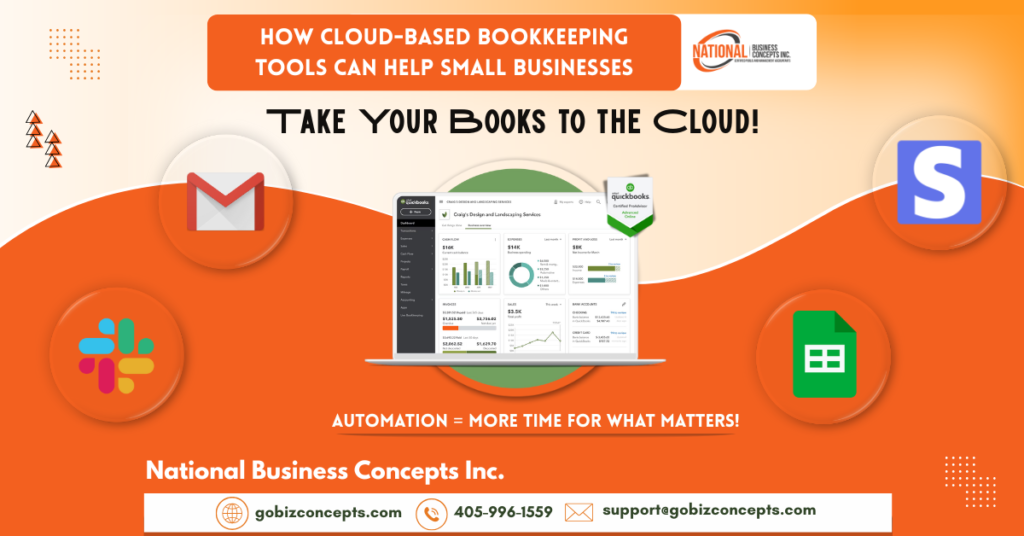Common Bookkeeping Mistakes
On the way to completing bookkeeping tasks, i.e., source analysis, journal entries, and posting to ledgers, there are many opportunities for mistakes. Common mistakes or issues include data entry errors, misplacing records, failure to track expenses or to a lesser extent failure to track revenues, inconsistent reconciliation, tax compliance failures, delayed cash flow visibility, and security risks.
Cloud computing offers streamlined processes and some mitigation for the common mistakes and issues revolving around standard bookkeeping computing models. Though these mitigations are not exclusive to bookkeeping in a cloud computing environment there are still benefits to specific to cloud computing discussed further on.
Cloud Computing For Bookkeeping
Specific to bookkeeping, first, cloud computing offers automated transaction recording that reduces manual data entry errors by extracting data directly from linked banked accounts, the use of optical character recognition (OCR) technologies, and through scanned ocumentation. Since paper-based records and local files can be lost, cloud computing offers digitised storage of documents, that are backed up, and easily and quickly retrievable through file indexing techniques, categorisation, AI-powered searches, metadata tagging, and scalability, i.e., the ability to handle massive datasets. Cloud-based computing offers consistent logging of expenses that are, again, categorised and analysed in real-time. Automated bank reconciliations ensure financial records match banking transactions precisely. Built-in tax features assist with reporting, filings, and compliance alerts. Dashboards and reports provide instant insights into revenue, expenses, and profitability. Cloud computing enables integration with other tools allowing seamless connections with payment processors, tax software, and business management platforms to create an efficient financial ecosystem. Finally, cloud solutions offer advanced encryption, multi-factor authentication, and automated backups to protect sensitive financial data.
Cloud Computing In General
Overall, cloud-based computing offers standard benefits such as cost efficiency, scalability, accessibility, security, collaboration, and automatic updates that are superior to the non-cloud-base environment. Since a business does not have to invest in expensive hardware, maintenance, costly upgrades, and a large IT staff, and can benefit from automation and AI-driven cloud tools, shifts in IT roles away from traditional IT to cloud administration, cybersecurity, and vendor management, cost optimization through scalability cloud computing improves its cost efficiency.
Further, cloud computing offers access to data and applications from anywhere with an internet connection; improved security through data encryption and backup; team collaboration on shared documents and applications in real-time; and automatic software and security updates made available by the cloud provider. As a bonus, cloud-based systems allow for greater transparency, making audits smoother and compliance easier.
Compliance
Cloud computing comes with several compliance concerns that businesses must address to ensure regulatory adherence and data security. There are data privacy regulations such as the General Data Protection Regulation (GDPR), California Consumer Privacy Act (CCPA,) or Health Insurance Portability and Accountability Act (HIPAA) if applicable. Then cloud computing requires strong encryption and security measures as the cloud environment can be vulnerable to cyber threats. Some regulations, like GDPR, apply data sovereignty—a principle that asserts that a country has the legal right to regulate and control data generated or processed within its borders—whilst others have data residency requirements—with a focus on the physical location of data storage, such as on-premises servers or third-party cloud services, especially applicable to Russia and China. Healthcare and finance have unique compliance requirements. Continuous monitoring and regular audits are essential for detecting vulnerabilities. Lastly, businesses must make sure that third-party vendors comply with regulatory standards and that they do not introduce additional risks.
Risks
There are many risks associated with cloud computing. First is the question of security. Storing data online exposes it to potential cyber threats like hacking, data breaches, and malware attacks. Next, service outages, downtime, or failures can temporarily block access to critical records. Third parties may not comply with service level agreements (SLAs) or SLAs may not meet regulatory requirements. Legacy bookkeeping systems may not sync with cloud platforms. Long-term cloud computing subscription fees may mount and that can be especially problematic if there is “Vendor Lock-In,” a situation where switching vendors can be onerous and challenging.
Conclusions
Cloud computing enhances bookkeeping by reducing errors, improving security, and streamlining financial tasks like journal entries and ledger updates. It mitigates common bookkeeping mistakes—such as misplaced records, reconciliation inconsistencies, and tax compliance failures—through automation and digitized data storage. Features like OCR, AI-powered searches, automated reconciliation, and real-time expense tracking improve efficiency and accuracy. Cloud solutions also offer encryption, multi-factor authentication, and seamless integrations with financial tools. While cloud computing reduces IT staffing needs, it fosters demand for cloud specialists, transforming business operations. Ultimately, it provides cost efficiency, scalability, accessibility, and collaboration, revolutionizing bookkeeping practices.
By Richard Thomas
Previous: Part I


